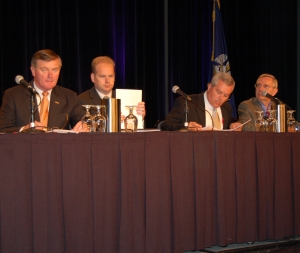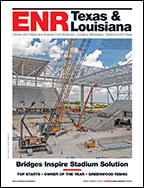Raising hurricane protection for Greater New Orleans to Category 5 status registered high on the list of issues for participants at a Louisiana Reconstruction and Recovery Conference that began in the city Nov. 10, but the 600 participants also are worried about the cost and time it would take to achieve it, and how their city will be safeguarded in the meantime.
 |
| An infrastructure panel was first on conference agenda. From left to right, Robert Flowers, USA (Ret.), now CEO of HNTB Federal Services Corp.; Rene Zijlstra, Director, Business Group, Coastal & Rivers Netherlands; Danny Taylor, Manager, Engineering, Entergy New Orleans, Inc. and Walter Brooks, executive director, Regional Planning Commission. |
They also recognized the importance of �keeping the story alive� if the region is to get the political and economic support it will need to see recovery through. Electronic polls conducted during the sessions indicate participants see that holding America�s attention long enough to devise effective reconstruction solutions and financing will be critical to success.
During and infrastructure panel that one of the lead-off items, Rene Zijlstra, a technical design engineer and project manager for several dike improvement projects in The Netherlands, told the audience that such a Category 5 level protection system could be built, but it will probably take one or two years for the design phase alone.
Several panelists stressed the need for local interests to unify behind a plan. Walter Brooks, head of the Regional Planning Commission, noted that establishing a �clear and non-competing set of priorities� is crucial for funding of such long-term projects. It was a sentiment echoed by former chief engineer for the U.S. Army Corps of Engineers, General (Ret.) Robert P. Flowers, now CEO of HNTB Federal Services Corp. �Competing plans will send mixed signals to Congress and likely reduce federal support,� Flowers said. �New Orleans� affected communities and the Gulf States must quickly identify a long-term, broadly-supported recovery plan.�
Balancing interests and determining priorities will lend more credence to the region�s appeals for funding at the federal level, Flowers said, adding, �Poorly planned and executed acquisitions will squander much of federal funding and dissuade support on the national level.�
 |
| Gov. Kathleen Blanco with Trula Remson, president of AIA Louisiana. |
Conference attendees also express concern about the quality of short-term storm protection while longer-term projects are designed and built, and they registered concerns about the quality assurances for building code enforcement and contract award processes in both the public and private sector during reconstruction, as well.
Brig. Gen. Robert Crear. chief of the Corps� Mississippi division and the commander of the Corps� mission to restore the levee protection system to pre-Katrina strength by next June, addressed some of those worries.
Crear said the Corps� understanding of the objectives and concerns of the Louisiana Recovery Authority, and the public�s understanding of the Corps process, will play an integrals role in the success of the mission. �We have to do our mission, regardless, but it�s important to do it in a climate where the people understand the process,� he said.
He observed that the public wants to have confidence in the integrity of the levee system, and noted that such confidence will have to be built on an understanding of the facts about the work. �The more people understand the facts...they think perhaps we are going to rebuild it and not take into consideration any safety,� Crear said, adding, by way of reassurance, �If in examination we find that the levee failures were due to material weakness or design, it is my responsibility to remedy that.�
Crear noted that the Corps has aligned itself with a variety of independent, expert data-gathering and analysis teams for such a system examination. �We have linked ourselves with them so we can incorporate those considerations into our designs for rebuilding,� he said. �We are going to make sure that as we find things that could have been a defect, we will remedy those defects in our rebuilding.�
The conference is presented by the American Institute of Architects, in collaboration with the American Planning Association. Co-sponsors include the National Trust for Historic Preservation and the American Society of Civil Engineers.
It is billed as a major planning and visioning effort to bring together officials and civic leaders, as well as ordinary citizens, to work out design and planning principles for the state�s post-Katrina rebuilding. Sessions focus on infrastructure, economic development, public services, environmental and public health issues and community building.
�This is a great opportunity to start a dialogue for what the opportunities are for rebuilding,� said Steve Dumez, vice president of the New Orleans architectural firm of Eskew+Dumez+Ripple. �It�s a first step. The goal is it will be a common vision established as a result and that will have enough legs to carry us through all the hard work to come.�
A desire for thoughtful, ethical, representative rebuilding efforts that include considerations for longevity and maintenance was the resounding theme of every speaker at the conference on Thursday.
Although the Big Easy has a well-deserved, laissez-faire reputation that stems from locals� tendency to sit on the porch fanning and sipping mint juleps rather than diving right into work, recognition of the validity of proceeding slowly and thoughtfully in this case has also been conference theme. Norman Koonce, executive vice president of the AIA spoke to the gathering about the importance of defining tasks and thoughtfully moving from conceptualization to practice. �If you don�t have the time to do the planning right, when will you ever find the time to do it over?� he asked.
Indeed, many speakers echoed Governor Kathleen Babineaux Blanco�s commitment to rebuild Louisiana �smarter, safer, stronger.� The Democratic governor said that although the country has never seen a disaster of the scope and magnitude of Katrina, she said it has also never before had such a wonderful opportunity to recreate such a unique city. �The citizens of Louisiana are all turning to people such as you to tackle this problem,� she said in the keynote address. �Louisiana residents have strong opinions, so prepare yourselves.�
Photos courtesy of American Institute of Architects



Post a comment to this article
Report Abusive Comment